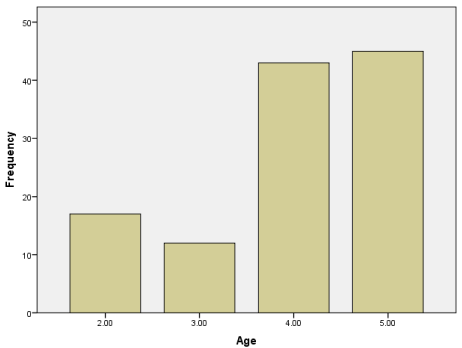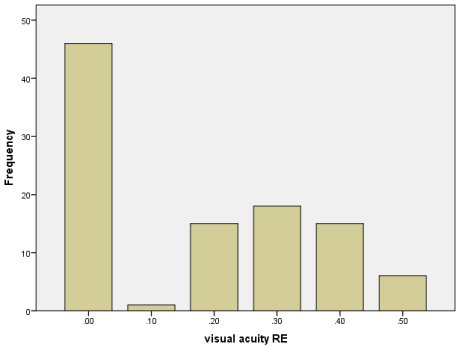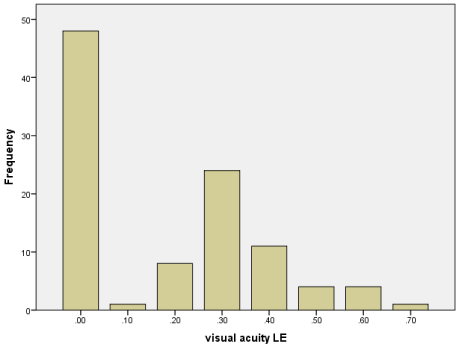
Research Article
Austin J Clin Ophthalmol. 2017; 4(2): 1080.
Normative Vision in Preschoolers in a Suburban City, South Western Nigeria
Bodunde OT¹* and Olatunji AA²
¹Department of Surgery, Olabisi Onabanjo University, Sagamu Campus, Nigeria
²Department of Radiology, Olabisi Onabanjo University, Sagamu Campus, Nigeria
*Corresponding author: Bodunde OT, Department of Surgery, Olabisi Onabanjo University, Sagamu Campus, Nigeria
Received: July 17, 2017; Accepted: August 09, 2017; Published: August 16, 2017
Abstract
Background: Visual acuity check in preschool children is often thought to be impossible. It is however an important step in eye examination which can help in screening/early detection of eye diseases that can later affects their vision in future.
Aim: To determine the normative visual acuity in preschool children in Sagamu, South Western Nigeria.
Methodology: This is a descriptive cross-sectional study among preschool children. Preschool children from a randomly selected Nursery and Primary school in Sagamu were recruited for the study. Their visual acuities were checked with Lea symbol at 3m. Data was obtained and analyzed with SPSS version 20. Frequencies and comparison of means was calculated using ANOVA method.
Results: A total of 117 preschoolers were examining. Their age ranged from 2-5years with a mean of 3.99 + 1.04 years. Forty-six (45.5%) of the children had visual acuity of 0.00 in the RE while 48(47.5%) had visual acuity of 0.00 in the LE .Visual acuity was found to increase with age in the Right and left eyes respectively. Seventy-eight (69.6%) children achieved equal vision in both eyes.
Conclusion: We conclude that visual acuity norms in preschoolers varies with age though at 5 years majority will have 0.00(6/6) logMAR vision and that it increases with age. Visual acuity in preschoolers can be checked with Lea symbols.
Keywords: Normative; Visual acuity; Preschoolers; Nigeria
KeywIntroductionords
Visual acuity is the ability to distinguish one object from another and to appreciate the details of an object. It is defined as the minimum angle that can be resolved by the eye at about 1 minute of an arc. The standard visual acuity in an adult is 6/6.
Visual acuity check is essential in children including preschoolers to be able to detect if their visual development is normal and also to detect and institute treatment early in cases of pediatric eye diseases. It can also be used for pediatric ophthalmic research. However, because of the varying stages of development in children, it is usually difficult to check their visual acuity with the standard Snellen’s chart. The method of checking visual acuity in children is age dependent and varies according to the level of cooperation. In preschoolers, it includes the use of Cardiff acuity charts, Leas symbols, HOTV matching, Kay picture test etc.
Normative VA levels in preschool children must be determined accurately so as to set referral criteria for vision screening [1]. It has also been said that normative visual acuity is a function of ethnicity and socio-economic status, hence need for setting population specific norms [1,2,3]. It is also related to the particular test used in determining the visual acuity and the age of the child [1]. There have been different studies on the normative visual acuity in preschoolers but none to the best to our knowledge from Nigeria [1,4,5,6]. This is because Pediatric Ophthalmology is just developing in the country. The aim of this study is therefore to determine normative vision in children 2-5 years using the Leas symbols.
Materials and Methods
A cohort of preschoolers from a randomly selected Nursery and Primary school in Sagamu were recruited for the study after obtaining ethical approval from the Olabisi Onabanjo University Teaching Hospital Health Research Ethics Committee and necessary approval from the school authorities. After this, consent was obtained from to the parents/guardians of the children. The children whose parents refused to sign the consent forms were excluded from the study.
The test was performed for all participants mono-ocularly; the Right eye was tested first at a distance of 3m using the Lea symbol chart in a well illuminated room. The child was asked to identify each optotype verbally but for those who could not a Matching test was done. The protocol was in 2 phases, the screening phase and the testing phase. During the screening phase, a single optotype is presented at several consecutive descending LogMA levels, until the child commits an identification error. Once an error is committed, phase 2 begins. During the testing phase, single optotypes were presented line by line from LogMA 1.0 in descending order. Visual acuity was recorded as the last level at which the child correctly identified three letters in this phase. Both cycloplegic and dry refraction were done with Topcom autorefractometer KR8900 to ensure normality. Significant error was hypermetropia of > +3D and myopia of < - 0.5D, astigmatism of >.1.0Dyl and anisometropia of > 1.0D. Comprehensive ocular examination including fundoscopy was later done.
Results
A total of 117 preschoolers were examined. There were 54(46.2%) males and 63(53.8%) females. The age range is from 2-5 years with a mean of 3.99 + 1.04 years. The median age was 4years. Forty-five (38.5%) were 5 year olds while 43(36.8%) were 4 year olds. The distribution of visual acuities according to age is shown in (Figure 1). Forty-six (45.5%) of the children who did the Lea symbols had visual acuity of 0.00 in the RE while 48(47.5%) had visual acuity of 0.00 in the LE. Visual acuity was found to increase with age in the Right and left eyes respectively (Tables 1 and 2). Seventy-eight (69.6%) children achieved equal vision in both eyes. Using the ANOVA table F=13.914, p=0.000 in the RE and F=7.229, p=0.000 in the LE. The significance was more in the RE.
Visual acuity RE
Mean age
Number
Standard Deviation
0.00
4.7609
46
0.43127
0.10
4.0000
1
0.20
4.3333
15
0.61721
0.30
3.4444
18
0.85559
0.40
3.6000
15
0.63246
0.50
3.8333
6
1.47196
Total
4.2277
101
0.85885
Anova F=13.914, P=0.000.
Table 1: Showing comparison of Means age and visual acuity RE.
Visual acuity LE
Mean age
Number
Standard Deviation
0.00
4.7083
48
0.45934
0.10
4.0000
1
0.20
4.3750
8
0.74402
0.30
3.7500
24
0.84699
0.40
3.4545
11
0.82020
0.50
3.7500
4
1.25831
0.60
4.0000
4
1.41421
0.70
3.0000
1
Total
4.2277
101
0.85885
Anova F=7.229, p=0.000.
Table 2: Distribution of Visual Acuity in the RE.
Sixteen (13.7%) of the children could not do the Leas symbol matching test. Eleven ( 68.8%) of these were 2 years old while 18.8% were 4 years.

Figure 1: Distribution of visual acuity according to Age.

Figure 2: Distribution of Visual Acuity in the RE.

Figure 3: Distribution of Visual Acuity in the LE.
Discussion
This study shows that preschoolers can have their visual acuities documented contrary to the believe of most eye care workers in the developing countries with little or no knowledge of Pediatric Ophthalmology. The result of this study confirms that preschoolers develop adult level of visual acuity around 5 years [1,5] and this has been said to coincide with the completion of maturation of optic nerve fibres and maturation of the fovea [6]. This study also found that visual acuity in children improves with age similar to other researchers [1,2].
It has been reported that apart from age, development of cognitive skill affects the visual acuity in preschoolers [1,4]. This may be the reason few of the 4year olds and some 2-3year olds could not do the Leas symbols. It is therefore advisable that every pediatric ophthalmology clinic have more than one chart for measuring visual acuity in preschool children. It is of note that the short attention span of these children can also contribute to the low vision that was recorded in some of them. Also, Socio-economic status of parents has been found to affect visual acuity in children [2]. This was not part of our study, hence one cannot categorically say this was the case with the 4 year olds who couldn’t do the Lea symbol.
It is difficult to compare the results of this study with the other studies on normative data as most of them used other testing instruments. Furthermore, the normative studies that do exist differ greatly in terms of optotypes, optotype size progression, crowding format, testing protocol and parameters known to affect visual acuity [5].
This study found that the Leas symbol is easily understood by the children. This was also noted by other researchers in their study [9,10]. It is said to have the advantage of using left-right symmetric optotypes, which overcome the young child’s difficulty with horizontal laterality [4,11]. Another advantage of Lea symbols test is that a lap card is available for each test, so that the child who is reluctant to identify the symbols verbally can identify the symbols by pointing to them on the lap card [4].
This study to the best of our knowledge represents the first normative data reported using Lea Symbols optotypes in Nigeria. It serves as baseline reference in clinical practice, vision screening and clinical research in preschoolers.
We conclude that visual acuity in this group of children improves with age as reported by other researchers.
References
- Leone JF, Mitchell P, Kifley A, Rose KA. Normative visual acuity in infants and preschool-aged children in Sidney. Acta Ophthalmol. 2014; 92: e521- 529.
- Friedman DS, Repka MX, Katz J, Giordano L, Ibironke J, Hawes P, et al. Prevalence of decreased visual acuity among preschool-aged children in an American Urban Population: The Baltimore Pediatric Eye Disease Study, Methods, and results. Ophthalmol. 2008; 115: 1786-1795.
- Pan Y, Tarczy-Hornoch K, Cotter SA, Wen G, Borchert MS, Azen SP, et al. Visual Acuity Norms in Pre-School Children: The Multi-Ethnic Pediatric Eye Disease Study. Optom Vis Sci. 2009; 86: 607-612.
- National Research Council (US), Committee on Disability Determination for Individuals with visual impairments, Lennie P, Van Hermel SB, editors. Visual impairments: Determining Eligibility for Social Security Benefits Washington (DC): National Academies Press (US); 2002.4, Assessment of vision in infants and children.
- Dover JR, Felius J, Cheng CS, Morale SE, Wyatt L, Birch EE. Normative paediatric visual acuity using single surrounded HOTV optotypes on the Electronic Visual Acuity Tester following the amblyopia treatment study protocol. JAAPOS. 2008; 12: 145-149.
- Salomao SR, Ventura DF. Large sample population eye norms for visual acuities obtained with Vistech-Teller Acuity cards. Invest Ophthalmol Visc Sci. 1995; 36: 651-670.
- Sonksen PM, Wade AM, Proffitt R, Heavens S, Salt TA. The Sonksen logMAR test of visual acuity: II .Age norms from 2 years 9months to 8 years. J. AAPOS. 2008; 12: 18-22.
- Magoon EH, Robb RM. Development of myelin in human optic N and tract. A light and electron microscopy study. Arch Ophthalmol. 1981; 99: 655-659.
- Cyert L, Dobson V, Kulp MT, Magure MG, Quinin G, Schmdit PP (Vision in Preshoolers study group). Opto Visc Sci. 2004; 81: 678-683.
- Osaiyuwu AB, Atuanya GN. Comparing visual acuity in preschool children using the Lea symbols and Sheridan Gardiner charts. Afr Vision Eye Health. 2015; 74: 3.
- Hyvärinen L, Näsänen R, Laurinen P. New visual acuity test forpre-school children. Acta Ophthalmol (Copenh). 1980; 58: 507–511.